5 unchanging wedding traditions of the royal family that You didn't Know about
Categories: Celebrities
By Pictolic https://pictolic.com/article/5-unchanging-wedding-traditions-of-the-royal-family-that-you-didnt-know-about.htmlVery soon, on May 19, the wedding ceremony of Prince Harry and his fiancee Meghan Markle will take place in St. George's Chapel. Thousands of Britons will gather on the streets of Windsor to see the happy newlyweds. Millions of people around the world will be watching the ceremony on TV or online.
To contrast with this Internet-era wedding (the second in a row after the marriage of William and Kate), we can recall how 125 years ago in 1893, the future King George V married Princess Mary of Teck: the couple married in the small royal chapel of St. James's Palace, where 100 guests could hardly fit.
And although at different times the weddings of members of the royal family took place in different ways, some rules never change, because the British royal family always remains a bastion of traditionalism. Let's remember a few such unchanging wedding traditions.
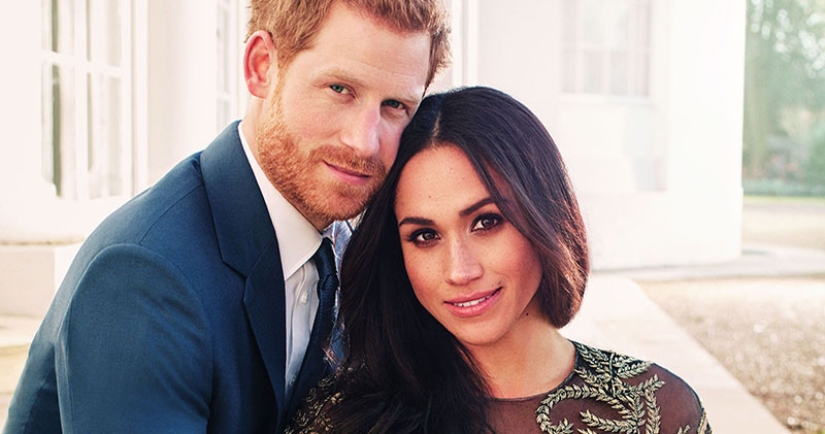 Source: Royal
Source: Royal
Wedding rings made of Welsh gold
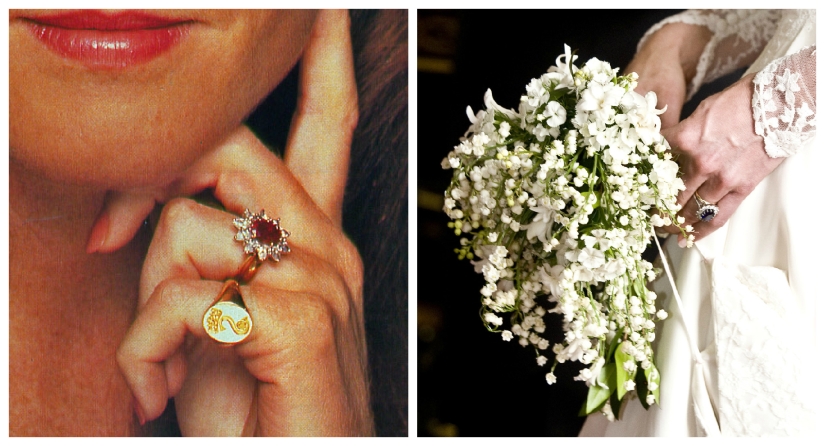
Left: wedding ring, engagement ring and signet ring of Sarah, Duchess of York. Right: the wedding of Prince William and Kate Middleton, April 2011
For more than 80 years, there has been a tradition to cast wedding rings for members of the royal family from Welsh gold. For the first time such a bride's wedding ring was used on April 26, 1923 at the wedding of the future King George VI and Queen Mother Elizabeth. Since then, Welsh gold has become a constant companion of all royal ceremonies in the UK.
Wedding rings of Princess Margaret, Countess of Snowdon, Royal Princess Anne, Princess Diana of Wales, Sarah, Duchess of York, as well as Prince of Wales and Camilla, Duchess of Cornwall, are made of Welsh gold. At the same time, only metal from the St. David's mine in Wales is used. Gold was mined there during the Roman occupation of Britain, but in the 80s of the last century its extraction was stopped.
There is very little original Welsh gold left. Fortunately, in November 1981, the Royal British Legion presented Elizabeth II with a 26-gram bar of Welsh gold of the 875th test, which is used exclusively for casting wedding rings of members of the royal family.
What rings Prince Harry and Meghan Markle will have will become known only on their wedding day.
A sprig of myrtle in the bride's bouquet
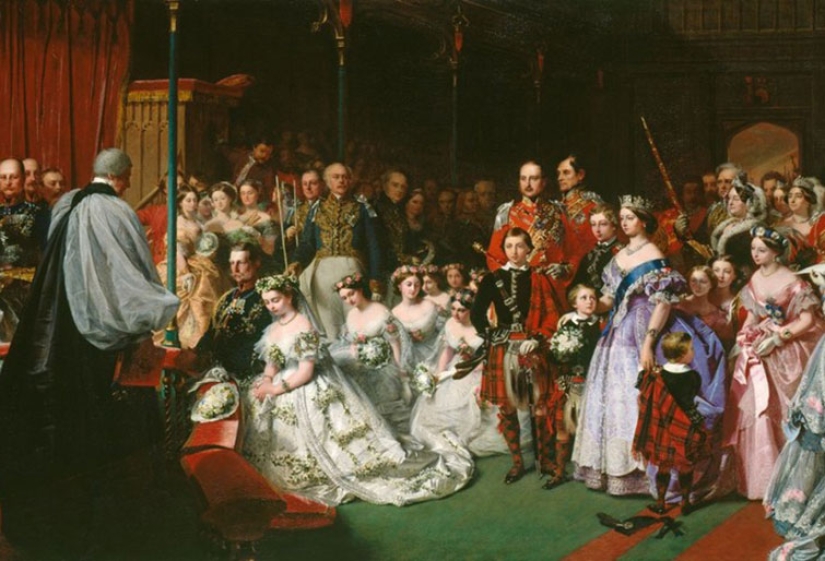
This 1960 painting by John Phillip depicts the wedding of Queen Victoria's eldest daughter, which took place in 1858
According to tradition, the bouquet of the bride from the royal family must contain myrtle branches from the summer residence — the Osborne house from the Isle of Wight in the English Channel. Why myrtle? The British call it the plant of love, and myrtle flowers symbolize innocence, happy marriage and fertility.
For the first time, twigs of this evergreen shrub appeared in the wedding bouquet of Queen Victoria in 1840. After the wedding ceremony, Victoria planted myrtle in her garden on the Isle of Wight, where it grows to this day. Myrtle branches from the Isle of Wight have been present in the bouquets of brides of the royal family since 1858. However, instead of throwing a bouquet into the crowd of unmarried friends, Meghan Markle will traditionally lay flowers at the Grave of the Unknown Soldier in Westminster Abbey in London.
Bouquet on the Grave of the Unknown Soldier
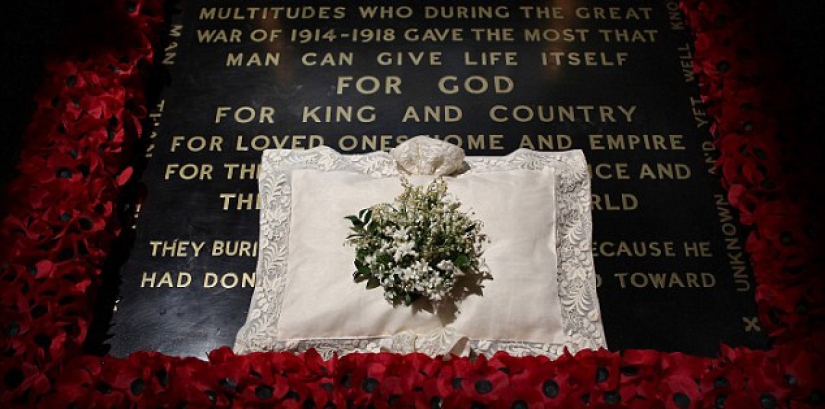 Almost 100 years ago, Lady Elizabeth Bowes-Lyon, the late mother of the now reigning Queen Elizabeth II, initiated another royal family wedding tradition. On the day of her wedding in Westminster Abbey, she laid her bridal bouquet on the Grave of the Unknown Soldier. In this way, she honored the memory of not only all the British soldiers who fell in the First World War, but also her own brother Fergus, who died in 1915 in the Battle of Loos.
Almost 100 years ago, Lady Elizabeth Bowes-Lyon, the late mother of the now reigning Queen Elizabeth II, initiated another royal family wedding tradition. On the day of her wedding in Westminster Abbey, she laid her bridal bouquet on the Grave of the Unknown Soldier. In this way, she honored the memory of not only all the British soldiers who fell in the First World War, but also her own brother Fergus, who died in 1915 in the Battle of Loos.
On her wedding day, April 26, 1923, Lady Elizabeth became the first bride to walk down the aisle without a bouquet in her hands, because she laid flowers on the Grave of the Unknown Soldier before entering the church. Since then, brides of royal blood in Britain have been taking their bridal bouquet to the monument, but they do it after the wedding ceremony.
Official Wedding Portraits
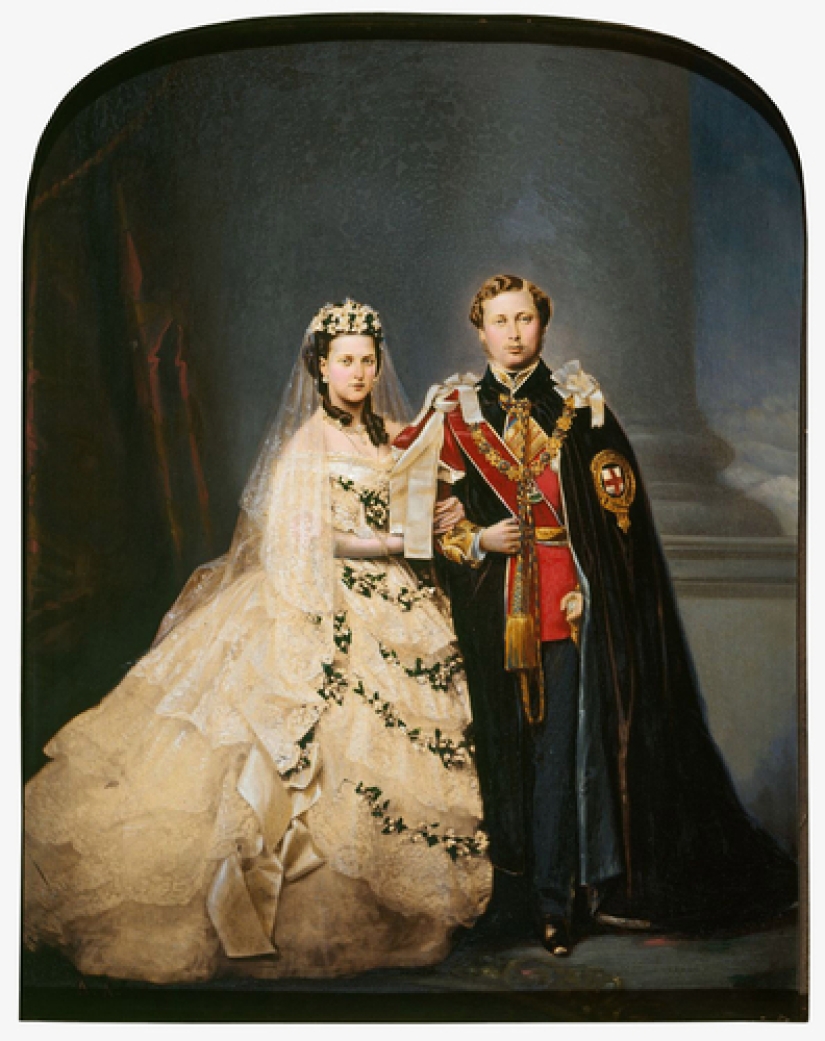
Wedding portrait of King George V and Princess Mary of Teck, 1893
Another tradition of royal weddings is an official photo shoot, which is usually held between the wedding ceremony and the wedding reception.
The first British monarch to make an official wedding portrait was King Edward VII, Prince of Wales. When he married Alexandra, Princess of Denmark, sister of the Russian Empress Maria Feodorovna, on March 10, 1863, numerous photographers attended the ceremony. Then the official black-and-white pictures were colored so that they looked like picturesque portraits.
At the beginning of the XX century, postcards with portraits of members of the royal family became popular, which the public began to collect en masse. So the official wedding portraits got a new life. For example, the photo presented above is one of the exhibits of a collection of photographs, postcards and documents that belongs to Miss Anya Gordon, a former maid of the royal residence.
As for Prince Harry and Meghan Markle, they chose Alexey Lubomirski, one of the most sought-after and stylish fashion photographers of our time, as their wedding photographer. Born in England, half Peruvian and half Polish, Lubomirski has already photographed the couple for their official engagement portraits.
Posted by Kensington Palace (@kensingtonroyal) on Dec 21, 2017 at 3:59 PST
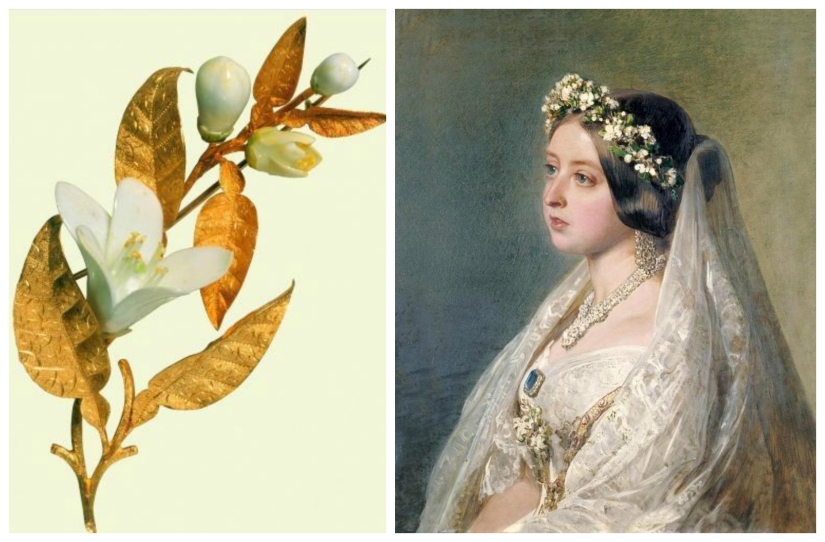
Queen Victoria in a wedding dress (portrait by Winterhalter) and a brooch, a gift from her fiance
At her wedding with Prince Albert on April 10, 1840, Queen Victoria did not wear a tiara: her head was decorated with a wreath with orange blossom, flowers of the orange tree (wild orange), a symbol of purity.
For the wedding, Prince Albert gave the bride a brooch in the form of a sprig of orange flowers with golden leaves and white flowers made of porcelain and later continued to give Victoria jewelry in this style. In the end, from 1839 to 1846, a beautiful parure (a set of jewelry) was assembled, consisting of a brooch with matching earrings and a headdress presented for the wedding anniversary.
It is thanks to Queen Victoria that orange blossom and the bride's white dress have become an invariable attribute of every traditional wedding. In the Victorian era, all princesses walked down the aisle with orange blossom in their wedding attire. This tradition was in use in the XX century: when Elizabeth II got married in 1947, her ivory satin wedding dress was embroidered with pearls and crystals in the form of bouquets of orange blossom, jasmine and white rose of York, which were combined with wheat ears symbolizing fertility.
Keywords: Great Britain | Queen Elizabeth | Royal family | Wedding
Post News ArticleRecent articles

Leonardo da Vinci was accused of being fond of orgies. William the Conqueror, despite all his successes, was called a "Bastard" ...

Modesty? Decency? A sense of tact? No, you haven't heard! Just look at what the people from the selection below are doing! No ...
Related articles

Kings can do everything, but they don't own my heart. Many monarchs were not happy in my personal life, married to those who were ...

In the color portraits of the 1870s, colored by the colorization expert Tom Marshall, children look at the lens too severely and ...

Among the Royal family always had a lot of interesting and unusual personalities. And one of the examples is the younger sister of ...

American documentary photographer Bruce Davidson came to the UK in 1960 for a couple of months on the assignment of Queen magazine. ...